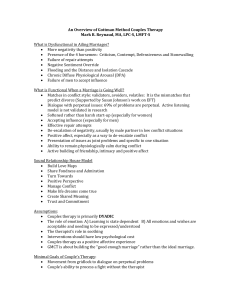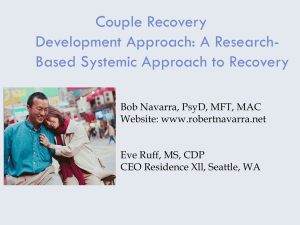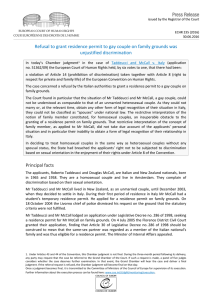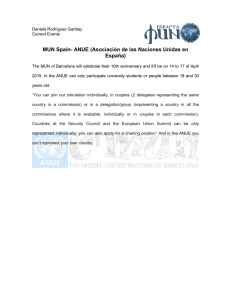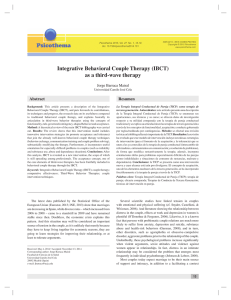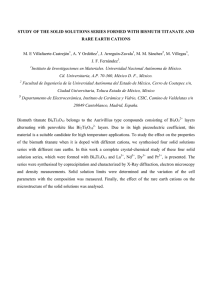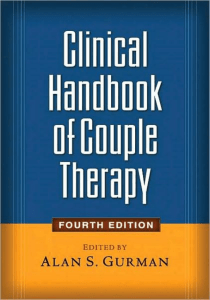AREAS OF CONFLICT IN THE INTIMATE COUPLE
Anuncio
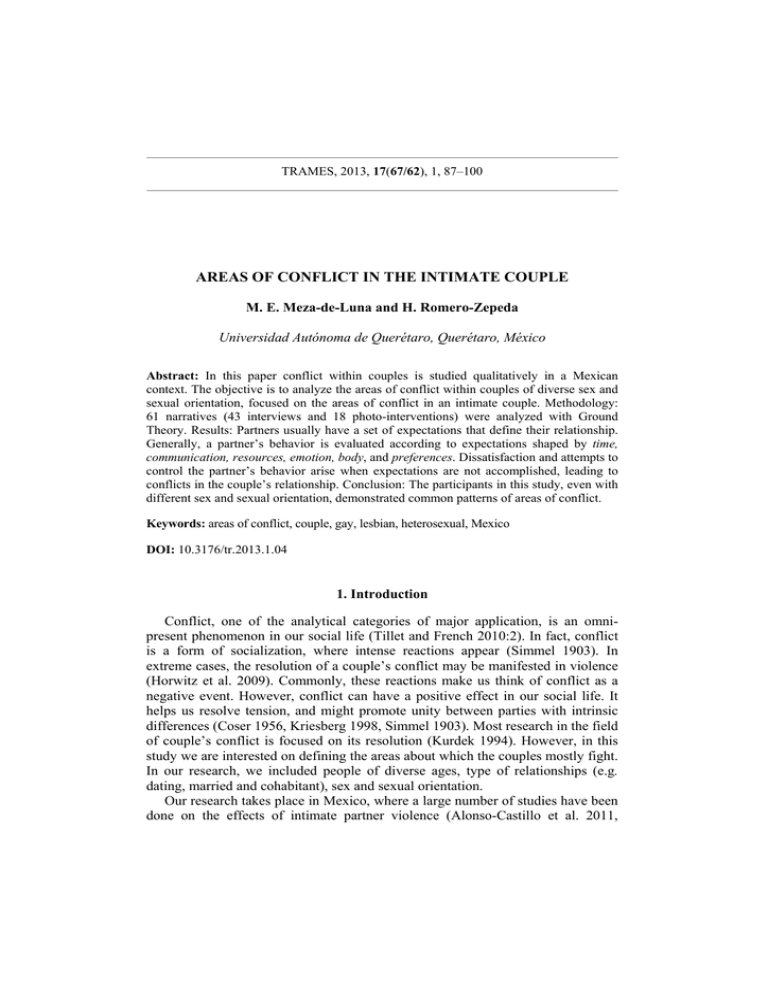
TRAMES, 2013, 17(67/62), 1, 87–100 AREAS OF CONFLICT IN THE INTIMATE COUPLE M. E. Meza-de-Luna and H. Romero-Zepeda Universidad Autónoma de Querétaro, Querétaro, México Abstract: In this paper conflict within couples is studied qualitatively in a Mexican context. The objective is to analyze the areas of conflict within couples of diverse sex and sexual orientation, focused on the areas of conflict in an intimate couple. Methodology: 61 narratives (43 interviews and 18 photo-interventions) were analyzed with Ground Theory. Results: Partners usually have a set of expectations that define their relationship. Generally, a partner’s behavior is evaluated according to expectations shaped by time, communication, resources, emotion, body, and preferences. Dissatisfaction and attempts to control the partner’s behavior arise when expectations are not accomplished, leading to conflicts in the couple’s relationship. Conclusion: The participants in this study, even with different sex and sexual orientation, demonstrated common patterns of areas of conflict. Keywords: areas of conflict, couple, gay, lesbian, heterosexual, Mexico DOI: 10.3176/tr.2013.1.04 1. Introduction Conflict, one of the analytical categories of major application, is an omnipresent phenomenon in our social life (Tillet and French 2010:2). In fact, conflict is a form of socialization, where intense reactions appear (Simmel 1903). In extreme cases, the resolution of a couple’s conflict may be manifested in violence (Horwitz et al. 2009). Commonly, these reactions make us think of conflict as a negative event. However, conflict can have a positive effect in our social life. It helps us resolve tension, and might promote unity between parties with intrinsic differences (Coser 1956, Kriesberg 1998, Simmel 1903). Most research in the field of couple’s conflict is focused on its resolution (Kurdek 1994). However, in this study we are interested on defining the areas about which the couples mostly fight. In our research, we included people of diverse ages, type of relationships (e.g. dating, married and cohabitant), sex and sexual orientation. Our research takes place in Mexico, where a large number of studies have been done on the effects of intimate partner violence (Alonso-Castillo et al. 2011, 88 M. E. Meza-de-Luna and H. Romero-Zepeda Vieyra et al. 2009) and domestic violence (Híjar-Medina et al. 2003, Saucedo 2009, Valdez 1998). Traditionally, these studies overlook the phenomena of interaction, a core element to understanding the process leading to violence (RamírezRodríguez 2006). This is, however, creating a void in the development of theoretical models empirically grounded in a couple’s conflict. This is important since a better understanding of the phenomena of conflict may have the potential to improve prevention and treatment interventions in sensitive issues such as violence between intimate partners (Marshall et al. 2011). 1.1. Related literature In a milestone work, Spanier (1976) created the field, ‘areas of conflict’. Spanier introduced the Dyadic Adjustment Scale, which aims to assess the quality of intimate relationships through the use of 32 items classified in the sub-scales of satisfaction, consensus, cohesion, and affective expression. Kurdek (1994), based in the conceptual work of Spanier (1976) and Bloom et al. (1983), defined the areas of conflict by having respondents indicate the frequency (1 = never, 5 = always) they and their partner fought or argued over 20 issues (i.e. finances, lack of affection, previous lovers, etc.). Kurkek grouped the areas of conflict in six categories: Power, social issues, personal flaws, distrust, intimacy, and personal distance. In Kurdek’s work, it was found that the frequency of occurrence was similar across gay, lesbian and heterosexual couples. Even with this precedent, there is a lack of qualitative investigation in the field of developing empirical theory that has evolved from systematizing the patterns emerging in the people’s experience. It should be stressed that culture, developed by different human groups, shapes the way a person defines, interprets and responds to problems (Klevens et al. 2007). Therefore, the development of empirical conceptual models is needed to provide Grounded Theory, suited to the specific culture with its current socio-historical context. In Mexico, since 1999, there have been advances in the field of conflict resolution in heterosexual relationships. The degree of conflict between a couple has been assessed by the Instituto Nacional de Estadistica y Geografia (INEGI; National Institute of Statistics and Geography) to evaluate the violence that can be exerted in the heterosexual couple, and specifically from men to women (e.g. INEGI 1999, INEGI 2004, INEGI 2007). To complete this task, a partnership between the United Nations Development Fund for Women (UNIFEM), the Women’s National Institute (Instituto Nacional de la Mujer, INMUJER) and the INEGI, recommended topics to be included in surveys. These surveys assessed the set of reactions and behaviors toward conflict resolution. Some areas of potential conflict stand out. These include decision-making about child education and discipline, expenses, sexual life and contraceptive methods, personal freedom, work division, and gender roles. However, these studies address only the heterosexual female population. This article studies areas of conflict in women and men of different sexual orientation, in order to contribute to understanding the reality in the Mexican context. Areas of conflict in the intimate couple 89 2. Method Institutions produce individuals, and individuals reproduce the structures of institutions that create them (Castoriadis 1986). In this study, we use a qualitative methodology to approach social subjects who represent their socio-historical moment. Their narratives contribute to defining and articulating the social order, which conveys values, norms, and beliefs, which make certain memories possible (Vazquez 2001). 2.1. Participants We followed a theoretical sampling approach (Straus and Corbin 2002), which consisted of collecting and analyzing new data and exploring in greater detail issues not originally addressed by the available data. First, we explained the study to key representatives from educational institutions. Depending on the internal procedures of each institution, we were allowed either to directly invite the community or the institution to distribute information about the study and our contact information. Word of mouth was particularly useful to contact same-sex couples. The inclusion criteria for sample selection required being Mexican with an experience of an intimate relationship (dating, cohabitation or marriage), participants had to be 18 or older, and to reside in an urban area. The sample included 61 participants (52.5% women, 21.3% with a same-sex partner); the mean age was 37.5 years (SD = 12.6), ranging from 18 to 69; 80.6% had a relationship of more than one year; 68% had a partner at the moment of participation; 42% were singles, 31% married, 14% divorced, 8% separated, and 6% cohabited with their partner; 41.6% had one or more children; and 80.6% had at least some studies at high school level. 2.2. Instruments and procedure The participants had an initial phone call or personal conversation for specifying the study information. In each call, following the American Psychological Association protocol (APA 2010), confidentiality and anonymity were promised. The general procedure was explained to them, the time and space for interviews was agreed. In most cases, the referral institution location was used to protect the conditions of privacy. We used two techniques for obtaining information: Interview and photointervention (Cantera 2009, Cantera 2010). The interviews (n = 43) were semistructured. They addressed the issue of why the interviewee was attracted to their partners, how the relationship started, what conflicts emerged and how they were managed, what each party did in a conflict situation, what made them stay or leave the relationship, and asked about their support networks. However, interviews were shaped by participant responses, since topics emerged and needed further exploration in subsequent interviews. On the other hand, photo-intervention is intended to focus on a subject through the use of photographs. The participants 90 M. E. Meza-de-Luna and H. Romero-Zepeda expressed their experiences and the meanings attributed to them through the narratives about the photographs they took. To this end, we provided disposable cameras to participants, asking them to take photographs about the couple’s conflict. we collected the cameras and printed the photographs before each group session. During our interviews, the participants talked about their photographs freely. We then followed a discussion of convergent themes that emerged among participants, and the relevant topics in the investigation. Afterwards, using the images captured by the group’s members, they selected around 10 to make a collective story about the couple’s conflict. Finally, there was a discussion on the values, cultural perceptions and structural issues of the conflict. In all cases, consent for the use of photographs was obtained. 18 people participated in 11 photo-interventions. Interviews and photo-intervention were conducted in one session, which lasted between 45 and 250 minutes, with an average length of 129.9 minutes. 88.9% of the sessions were recorded digitally; in the rest, there were either technical errors with recording or a lack of consent. In cases where there were no recordings, we validated the summaries of meetings with the people interviewed, by telephone or e-mail. Participants’ names were changed. Interviews were transcribed verbatim in Spanish, but we provided an English translation of the quotations included here. 2.3. Analysis of information We analyzed the data with the Grounded Theory (Staruss and Coser 2002). Each transcribed interview was read repeatedly to provide a code to the data set that shared properties. We followed the constant comparison procedure, where each new event that belonged to a category was compared to the similarities and differences of previous events in the same category, contributing to the density of properties and dimensions on each category. Comparisons between categories and subcategories were made at a multi-dimensional level, exposing relationships between them. At the same time, analytical notes (memos) were written when relevant issues were found. The emergence of concepts and relationships raised new possibilities for analysis until theoretical saturation was achieved; that is, the point where new data provided little or no additional information to the theory. The simultaneous processes of collecting data, coding, analyzing information and writing memorandum, were iterative. After the core categories emerged, the selective coding process was used to integrate and refine the conceptual codes. In this analysis, we used computer tools such as Audacity version 1.2.3 (Bland, et al. 2004) to improve sound; Sound Scriber (Breck 1998) for the verbatim transcription; Atlas.ti version 5 (Atlas.TI 2007) for analysis; and Cmaps version 4.02 (IHMC 2007) for relational diagrams. The credibility and reliability in the research process is underpinned by the commitment to the field (Mendizábal 2006; [our translation of: Compromiso con el trabajo de campo]). This is with the complete and verbatim transcripts of interviews, distinguishing original data from researchers’ interpretations through the memorandum, seeking the wealth of data by including different groups of people Areas of conflict in the intimate couple 91 with a variety of: (1) couple experiences like dating, cohabitation, marriage, divorce or separation; (2) sexual orientation; (3) age; (4) degrees of perceived aggression from none or little to physical abuse. Also, as much as possible, we made communicative validation (Mendizabal 2006.); the participants evaluated the summaries of the interviews. Furthermore, we did triangulation using two techniques at different times and stages, the first stage with interviews and in the second with photo-intervention (Cantera 2009, Cantera 2010). 3. Findings and discussion Conflicts within couples are related to the core category of Areas of conflict, which is described as the issues about which the couples have disputes. We will discuss the general process in conflict between partners as a frame to understand the Areas of conflict. This section explains Figure 1. 3.1. General process in a couple’s conflicts Expectations are a decisive factor in a couple’s conflicts. Both persons in a couple, regardless of sex or sexual orientation, has a set of expectations intended to be satisfied, and at the same time it serves to establish limits. It modulates how each member has to be or what they do inside and outside the relationship (e.g., with family or friends), and in different contexts (e.g., home, party, vacations). When the limits derived from expectations are not met or are perceived as trans- Figure 1. Areas of conflict in the couple with categories and sub-categories. 92 M. E. Meza-de-Luna and H. Romero-Zepeda gressed, the opportunity to demand a change will arise, and so does the conflict. In concordance with previous investigations, expectations were influenced by age and gender ideology (Lee, 2008), where socio-cultural circumstances define expected norms of interactions; such as authority, responsibilities, or work division (see Frost and Dodoo 2010). A couple’s conflict arises under their different perceptions of the transgression of limits (category in vivo). In general, people use limits to establish a line to differentiate among what is allowed, good, or valid, from what is not; they are thresholds used to shape and inform interactions. When limits are crossed, negative feelings are awakened in individuals. In everyday interactions there is a sensing process, where each person takes into consideration his/her negative feelings (e.g. dissatisfaction or discomfort) with respect to the interaction. Commonly, couple’s conflicts appear when the following conditions are met: (1) limits are perceived as transgressed and (2) intolerable feelings of dissatisfaction emerge, enough to exert actions with the purpose of keeping the limits that were broken under control (e.g. Karla, a married 24 year-old heterosexual woman: ‘I do not want them to mess with what is mine, nor with what I love, and I try to take care as best as I can, but this limit was surpassed, then I got really upset and I started to fight with my husband’), see Figure 1. 3.2. Areas of conflict: what do couples argue about? Areas of conflict are shaped by limits. Even when both persons in a couple establish specific limits and the thresholds may change among different people, there are patterns about subjects where conflict emerges. They are the areas where actions are frequently taken to control the partner's behavior that is perceived as intolerable transgression. This section will describe the areas where the couple’s conflict appears according to expectations: time, resources, communication, emotions, body, and preferences. 3.2.1. Time In an intimate couple the measurement of time is a parameter that helps to reach agreements and decisions. It has different functions: (1) To synchronize events; e.g. ‘we will meet in 10 hours’, (2) to establish boundaries or achieve goals; e.g. ‘next year, we will buy a car’, (3) to introduce trademarks of events; e.g. ‘our daughter was born in 1993’, (4) to give parameters to guide actions or to restrict them; e.g. ‘if you do not arrive in 15 minutes, I am going to leave’. This creates expectations in the couple, often associated with planning. Time is an area of conflict in the couple. Conflicts might arise when there is no agreement between expectations with respect to time; and it appears that time can be used to make a partner behave according to that expectation. Usually, it includes control over how the time should be used or how the partner should be in that time; resulting in monitoring the partner’s use of time. This is a practice in the interaction of subjects who try to live according to their personal agenda, which differs between individuals (Straus 1979). Areas of conflict in the intimate couple 93 Time is used as a parameter on which an event is expected to happen. The conflict can appear when expectations are not met by the partner; regarding a temporal sequence, or synchronized/predicted actions. Oliver, a 48 year-old gay man, had conflicts with his partner due to his frustration when meeting his partner: ‘He was very UNPUNCTUAL, he said “I will arrive at 2”, and it was 3, 4, he arrived at 6 or 7’. Oliver interpreted this unpunctuality as lack of compromise and love from his partner. Additionally, time is used to establish boundaries and to control the partner’s actions; like counting the amount of time to do something or to be with someone. For instance, Dina, a 57 years old heterosexual woman, complained about her dissatisfaction when her husband takes photographs while travelling: ‘He takes so much time taking pictures that I despair’, or Juanita, a 28 years old heterosexual woman, who was given 15 minutes to arrive to her house after work, otherwise her husband was suspicious about her fidelity. Hence, time is used as parameter to impose a limit to the partner’s actions, going beyond it was seen as intolerable. Therefore, time can be used as a parameter to guide or restrict a partner’s actions. As a result a hierarchy is imposed on the partner’s agenda by monitoring his/her departures and arrivals, schedules and what he/she does with his/her time (e.g. Clara, a 26 year-old heterosexual woman who is cohabitating with her partner, said: ‘It is invading the time of the other person. One wants to live the life of the other’). On the other hand, time is used as a marker, as a method of remembering undesired events with high negative impact on the wellbeing; for example Karla recalled the time when she and her husband had a violent episode with fighting and shouting. Time also identifies repeated undesired events as a way to assess synchronicity. It is used as a dimension to measure frequency and duration of an undesired behavior or events (e.g., Pao, a married 48 year-old heterosexual woman: ‘my husband is drunk every weekend’). Time as an indicator, with negative connotations, is a source of conflict when used as claim or reference into the couple’s interactions. 3.2.2. Resources Resources are socially valued objects used as a means to empower achievement. In the couple, valued objects could include: (1) tangible, real objects that can be touched or (2) symbolic, intangible objects loaded with high social significance. Symbolic resources are concepts and social constructions that have meaning in a certain place and time. For instance, to have good manners, education, or be older, are related to different cultural meanings, such as power, status, or responsibility. Within a couple, resources have the characteristics of being seen and used as possessions that enable people to act. As a possession, it is subject to being administrated or given some degree of accessibility to it (e.g. null, free, negotiated, restricted). People in a partnership bring and generate tangible and symbolic resources to the relationship. Tangible resources are realized in material possessions (e.g. 94 M. E. Meza-de-Luna and H. Romero-Zepeda houses, cars, food, furniture, money). Symbolic ones comprise real or pretend intangible possessions that a person claims to have. They can be clustered in: (1) Personal capacities demarcated as the ability of people to possess specific skill sets. They are assessed with the following sub-categories: education (null to superior); intellect (intelligent/dumb); charisma (such as physical or sympathetic); socio-economic class; and civility (sub-category in vivo) defined by how people interact socially through their expression (verbal/behavior) that can be either polite or rude. (2) Personal relations are relationships outside of the couple, usually with strong bounds where the person has identification and emotional ties; such as family of origin, dependents (e.g. children, siblings, pets), and friends. It is considered a resource because they are perceived as a source of strength that enables people to do or to have. Resources are related to different expectations in the couple; when a partner’s expectations are not met it becomes an area of conflict. Resource expectations are characterized by a degree of demand imposed on the partner, and where conflict might emerge (e.g. Karla: ‘You're not bringing money […] you gave me 100 or 200 pesos a week, it is not enough’). Resource expectations are crossed by gender ideology and related to material possessions, personal capacities, and personal relations. Specifically, heterosexual couples are characterized by the division of two spheres of competence and responsibility; bread-winner and domestic affairs, in concordance with gender ideology (see Lee 2008, Frost and Dodoo 2010). This division brings expectations leading to demands and conflicts; like Betty, a separated 47 year-old woman, said to her husband: ‘it is your duty; nobody will come to maintain your sons’. Also, a couple’s disagreement may be related to the different limits each person in the couple has, corresponding to divergent expectations. For example, dependents (e.g. children, siblings, pets) are often related with conflicts because of the different expectations among the couple about rules, responsibilities, authority, and the expected behavior of each partner; like Nina, a 24 year-old lesbian woman, who was living in the home of her partner, complained about the uselessness of her partner’s brother, but her partner had another perspective and replied: ‘you get out of my house, this is not yours, my brother is at his home and he does what he wants’. Also, resources are an area of conflict in couples through two mechanisms: To impose hierarchies and defense. Resources can be used to control by imposing hierarchies, like Karla who refused to obey her husband’s commands: ‘I have a degree and you're a high school student, so if someone has to command that will be me’; this education differentiation, as symbolic resource, was used as a matter of hierarchy and control. Karla thought that hierarchies are imposed constantly in the interactions, and are a source of conflict: ‘Always someone is higher, intellectually, educationally, economically, ‘Ah no, I'm more’, always, both men and women’. Hierarchies establish a pecking order, leading to relationships of power where tangible and symbolic resources are used to differentiate and take advantage of. Besides, under the ‘possession’ meaning of resources, people develop mechanisms of defense. Defense is characterized with actions intended to Areas of conflict in the intimate couple 95 protect the resources perceived as threatened. For example, frequent conflicts are triggered under the perception of menace over the personal relationship. Especially, family of origin and children are defended as property and as a way to validate oneself. This defense is related to the degree of affinity and emotional/ physical attachment (e.g. Betty: ‘We had some problems because he was rude to my brothers’). As an extension, these dynamics of defense were found over preferences, actions, omissions, ideals and beliefs of the family as an inheritance to which the person adheres (e.g. Karla: ‘We [as a family] do it in that way’). The mechanism of defense is characterized for promoting alliances (null, short, temporal or undefined), leading to squabbles between sides, in imitation of xenophobia (e.g. Karla: ’every time you come back from your house [the husband’s parents] you fight with me. So what happens? What do they tell you? Why do you arrive so angry at me, so enraged?’). Hence, a defense mechanism is motivated by a perceived threat, and a perception that one’s partner is being hostile, critical, blaming, or controlling (Sanford 2010). 3.2.3. Communications Communication in a couple is the process of transferring information. The information is a way of concentrating or encapsulating events. It concentrates, among others, on words, emotions, expectations, decisions and plans. It is related to the past and future of the relationship. Thus, the information typically originates in various topics such as everyday events, time and available resources. Hence, communication is linked to other areas of conflict: time, body, emotions, resources and preferences. Communication is characterized by: (1) Availability is the degree of information shared (null, restricted, and free). It is a dynamic of the flow of information, ranging from transparent and shared between the couple, to static and unilateral. (2) Appropriateness is the degree of pertinence to communicate, related to the appropriate moment, place and form (i.e. tone of voice) to transfer information. (3) Protocols, such as what media to use to attempt communication. Protocols can be behavioral (gestures) or oral, with direct or indirect approaches. Direct protocols characterized by face to face interaction involve the perceptual system and provide a chance of immediate feedback. Indirect protocols make communication without the partner’s physical presence. It includes information and communication technologies (e.g. internet or phones) and traditional paper writings. A couple’s conflict might emerge when expectations about communication are not similar. Both persons have expectations about how communication should take place, what should be told, when, and through what media. When expectations about availability, appropriateness and protocols in communications are not met, conflict can arise. For instance, Nina had arguments with her partner because they had different expectations over the appropriate or pertinent period of time to communicate: ‘you went on your trip and did not even warn me in advance’. The members of a couple have expectations about the topics that should be informed, 96 M. E. Meza-de-Luna and H. Romero-Zepeda so some degree of coercion is imposed (e.g. Lina, a 58 year-old heterosexual woman cohabitating with her partner, said that her partner complained about her loss of virginity: ‘why did you do it, with whom?, Why you did not wait for me?’). 3.2.4. Emotions Emotions are intrinsic to interactions in a couple. Commonly, strong emotions and feelings motivate the establishment of intimate relationships. Besides, emotions and their related feelings are conditional to the appearance of disagreements in a couple (see Sanford 2007a, 2007b). As mentioned before, conflict arises as a response to a change that is perceived as intolerable. Frequently, emotions and feelings are highly related to communication. The category of emotion has the properties of emotional expressions (e.g. cry, laugh), the exteriorization of the internal movement of the person through different methods, e.g. verbally or through gesticulations. Expectations over emotions lead to another area of conflict among couples. Emotional expression is associated with expectations about: (1) Validity; limited by what can or should be felt in accordance with the circumstances (e.g. Nina: ‘you should be grateful’). (2) Pertinence is a degree of allowance to express emotions and feelings (e.g. ‘do not cry’). It defines the fluidity of emotional expression, formed by the frequency of repression exerted by oneself and the partner (e.g. Martha, a single 28 year-old lesbian woman: ‘You repress yourself; you put yourself in defensive manner when I am affectionate, and I do not want to control my emotions’). Conflict can be trigged when certain emotions and feelings in the partner’s response were not expected, or because the emotional expression is perceived as intolerable. 3.2.5. Body The human body can do, express and move in time and space. In a couple, it is through the body that interactions can happen. Body is a fundamental aspect in the conflict. Everything to what the body is linked can be evaluated and subject to conflict. The body has the properties of health, sexuality, appearance, and the capacity of doing (e.g. working or interacting). The body is an important area where conflicts in the couple emerge. The use and management of the body come to be controlled in couples when expectations are not met and are perceived as going beyond tolerable limits. The body’s expectations are related to: (1) the partner’s health, concerning medical reviews, dietary intake and exercise (e.g. Hugo, a married 51-year-old heterosexual man: ‘I care much for the food, she likes the fried food and usually I start the sermon’). (2) Sexuality, related to reproduction (e.g. Hugo: ‘I proposed the abortion […] but now, she has not forgiven me’), virginity, and sexual activity and intercourse; such as different sex frequency expectations. (3) Appearance is associated with physical aspects and clothing; these correspond to some partner’s ideals and the pressures to meet what is seen as superior or adequate (e.g. Lola, a single 21 year-old Areas of conflict in the intimate couple 97 heterosexual woman: ‘[her boyfriend said] What are you wearing? If you do not change your clothes, I will not take you to dance’). (4) Capacity of doing is the ability to move and perform something. Expectations about what partners should do are present in the couple. For instance where the partner should work; with whom the person should, or should not, interact; and how different parts of the body (e.g. hands or face) should be involved in those interactions (e.g. Lina: ‘He was upset because I greeted our friend with a kiss’; Martha: ‘She was jealous because another girl was looking at me, she said I was always flirting’). 3.2.6. Preferences Preferences correspond to the chosen things, persons or situations. In a couple, both persons bring a cluster of preferences that sometimes disagree with their partner’s, thus increasing the chances of conflict. Preferences, as a category, have two dimensions: (1) Order concerning how the things should be placed or the rules that someone needs to follow to perform an activity and have a certain result. It comprises a wide range of activities in everyday life, such as cleaning, where and how to place things, or what activities should be done first (e.g. David, a 34 year-old gay man, who is cohabitating with his partner: ‘Even the way I sweep the floor, he wants me to do it in a certain way’). (2) Likes; it is related to what is considered to be fun, tasty, or looks pretty. It is linked to what is pleasant to the senses, such as colors, shapes, smells, sounds, textures or flavors. Additionally, it includes activities that produce pleasure, such as sports, eating a particular type of food, smoking, or hobbies. Preferences can be an area of disagreement in couples when control over the partner’s preferences appears. Order and likes are related to habits and beliefs, which are almost inevitable to be divergent in a couple. The difference between how things should be done or placed (order) and what is fun, tasty, or looks pretty (likes) can initiate conflict within the couple (e.g. David: ‘the disorder of the table is a conflict, sometimes I arrive tired, or maybe I leave things here and there, and cause many conflicts, and he likes everything impeccable’). Hence, preferences include what and how to define and manage the living spaces; such as color selection for home/furniture, or how to maintain the common space. 4. Conclusion This study conceptualized the areas of conflict in a couple at an abstract level. Empirically, we found that conflict within a couple is defined by the perceived transgression of expectations, which produce sufficient dissatisfaction to exercise control, making the partner to adjust to ‘appropriate or valid’ limits, according to the evaluation of who exerts the control. The expectations define a common pattern of areas of conflict in the couple over time, possessions, communication, emotions, body and preferences. Often, several of them are mixed in a single 98 M. E. Meza-de-Luna and H. Romero-Zepeda conflict. The participants in this study, even with different sex and sexual orientation, presented common patterns of areas of conflict, showing that the areas of conflict transcend sex and sexual orientation. The model presented is culturally adapted to the actual Mexican social context, filling a void in the understanding of the social interactions, not just by studying heterosexual women, but by giving voice to different types of couples. The prevalence of the areas of conflict in any type of couple, points out the relevance to reframe the study of a couple’s conflict to embrace any sex and sexual orientation, as a human phenomenon that is more complex than just gender affairs among heterosexuals. It is a call to overcome a hetero-centrist way of thinking and acting, and move into an inclusive human understanding, where each human being has historical and social liaisons that influence its interactions. The intersubjectivity involves women and men of any sexual orientation. Study’s Limitations. The sample included middle-class people living in Querétaro, the central part of Mexico. Further investigations need to address people living in poor conditions or marginalized zones. Declaration of conflicting interest The authors declare no potential conflict of interest with respect to the authorship and/or publication of this article. Acknowledgements This research was conducted, in part, through a scholarship from CONACYT, Mexico. The authors thank the participants for their time and generosity and Sarah Bruce for her help in the revision of the manuscript. Address: M.E. Meza-de-Luna Facultad de Ciencias Políticas y Sociales Circuito Universitario Las Campanas. Centro, C.P. 76000 Querétaro, México Phone: + 52 442 192 12 00 ext. 5451 E-mail: PrevenirAbuso@gmail.com References Alonso, M. M., K. S. López, S. E. Esparza, R. Martínez, F. R. Guzmán, and B. A. Alonso (2011) “Violencia contra la mujer y su relación con el consumo de drogas en el área metropolitana de Monterrey, Nuevo León, México”. Investigación en Enfermería. Imagen y Desarrollo 11, 1, 81–95. Areas of conflict in the intimate couple 99 American Psychological Association (2010) The publication manual of the American Psychological Association. 6th ed. Washington, DC: American Psychological Association. Atlas.ti 2003. The knowledge workbench. Visual qualitative data analysis (version WIN 5.0) [Software for computer]. Berlin: Scientific Software development. Bartos, O. and P. Wehr (2002) Using conflict theory. Cambridge: Cambridge University Press. Bland W., V. Busam, B. Gunlogson, G. Mekkes, and A. Saunders (2004) Audacity 1.2.3. Available online at <htpp://audacity.sourceforge.net/>. Accessed on 30.01.2006. Bloom B. L., W. F. Hodges, and R. A. Caldwell (1983) “Marital separation: the first eight months”. In E. J. Callahan and K. A. McCluskey, eds. Life-span developmental psychology: nonnormative life events, 217–239. New York: Academic Press. Breck, E. (1998) SoundScriber. Transcriptor computacional para el proyecto MICASE, English Language Institute, University of Michigan. Available online at <http://www.lsa.umich.edu/ eli/micase/soundscriber.html>. Accessed on 15.05.2006. Cantera, L. (2009) “La fotointervenció com a eina docent”. Rep:TE. Revista d’Ensenyament de la Psicologia: Teoria i Experiència 5, 18–30. Cantera, L. (2010) “La fotointervención como técnica de concienciación de la violencia de género”. In Gênero & Saúde: diálogos Ibero-Americanos. M. Ruwer, ed. Porto Alegre: Edipucrs. Castoriadis, C. (1986) El Campo de lo social histórico. México: ANUIES. CmapsTools (2007) Knowledge modelling kit v4.10 WIN. University affiliate research institute. Available online at <htpp://cmap.ihmc.us>. Accessed on 20.05.2005. Coser, L. (1956) The function of social conflict. New York: The Free Press. Davis, S. N. and T. N. Greenstein (2009) “Gender ideology: components, predictors, and consequences”. Annual Review of Sociology 35, 87–105. Frost, A. E. and F. N. Dodoo (2010) “The man comes to marry the woman: exploring adolescent boys’ gendered expectations for bridewealth and marriage among the akwapim of Southern Ghana”. Marriage & Family Review 46, 1–2, 41–59. Ibañez, T. ( 2004) “El cómo y el por qué de la psicología social”. In Introducción a la psicología social, 51–92. T. Ibañez, ed. Barcelona: UOC. Instituto Nacional de Estadística y Geografía, INEGI (1999) Violencia intrafamiliar encuesta 1999: Documento metodológico y resultados. México: INEGI. Instituto Nacional de Estadística y Geografía, INEGI (2004) Encuesta nacional sobre la dinámica de las relaciones en los hogares, 2003: ENDIREH. Características metodológicas. México: INEGI. Instituto Nacional de Estadística y Geografía, INEGI (2007) Encuesta nacional sobre la dinámica de las relaciones en los hogares, 2006: ENDIREH. Marco conceptual. México: INEGI. Híjar-Medina, M., L. Flores-Regata, R. Valdez-Santiago, and J. Blanco (2003) “Atención médica de lesiones intencionales provocadas por la violencia familiar”. Salud Pública Mexico 45, 252– 258. Horwitz, S., L. Santiago, J. Pearson, and M. LaRussa-Trott (2009) “Relational tools for working with mild-to-moderate couple violence: patterns of unresolved conflict and pathways to resolution”. Professional Psychology: Research and Practice 40, 3: 249–256. Klevens, J., G. Shelley, C. Clavel-Arcas, D. D. Barney, C. Tobar, E. Duran, R. Barajas-Mazaheri, and J. Esparza (2007) “Latinos perspective and experiences with intimate partner violence”. Violence Against Women 13, 2, 141–158. Kriesberg, L. (1998) Social conflict. 2nd ed. Upper Saddle River, NJ: Prentice Hall. Kurdek, L. A. (1994) “Areas of conflict for gay, lesbian and heterosexual couples: what couples argue about influences relationship satisfaction”. Journal of Marriage and Family 56, 4, 923–934. Lee, S. H. (2008) “Marriage expectation and related factors among college students”. Korean Journal of Women Heath Nursing, 14(2), 124–130. Marshall, A. D., D. E. Jones, and M. E. Feinberg (2011) “Enduring vulnerabilities, relationship attributions, and couple conflict: an integrative model of the occurrence and frequency of intimate partner violence”. Journal of Family Psychology 25, 5, 709–718. 100 M. E. Meza-de-Luna and H. Romero-Zepeda Mendizábal, N. (2006) “Los componentes del diseño flexible en la investigación cualitativa”. In Estrategias de investigación cualitativa, 65–105. I. Vasilachis, coord. Barcelona: Gedisa. Ramírez-Rodríguez, J. C. (2006) “Male violence against heterosexual partners: facts and challenges”. Salud Pública de México 48, s315–s327. Ross, M. H. (1983) “Political decision making and conflict: additional cross-cultural codes and scales”. Ethnology 22, 2, 169–192. Sanford, K. (2007a) “The couples emotion rating form: psychometric properties and theoretical associations”. Psychological Assessment 19, 411–421. Sanford, K. (2007b) “Hard and soft emotion during conflict: Investigating married couples and other relationships”. Personal Relationships 14, 65–90. Sanford, K. (2010) “Perceived threat and perceived neglect: couples’ underlying concerns during conflict”. Psychological Assessment 22, 2, 288–297. Simmel, G. (1903) “The sociology of conflict”. American Journal of Sociology, 490–525. Spanier, G. B. (1976) “Measuring dyadic adjustment: new scales for assessing the quality of marriage and similar dyads”. Journal of Marriage and the Family 38, 1, 15–28. Saucedo, I. (2009) “Familia y violencia. Violencia doméstica y sexual”. Demos 8, 32–35. Straus, M. (1979) “Measuring intrafamily conflict and violence: the conflict tactics (CT) scales”. Jorunal of Marriage and the Family 41, 1, 75–88. Staruss, A. and J. Corbin (2002) Bases de la investigación cualitativa: técnicas y procedimientos para desarrollar la teoría fundamentada. Medellín: Universidad de Antioquía. Tillet, G. and B. French (2010) Resolving conflict. 4th ed. New York: Oxford University Press. Valdez, R. and C. Juárez (1998) “Impacto de la violencia doméstica en la salud mental de las mujeres: análisis y perspectivas en México”. Salud mental 21, 6, 1–10. Vázquez, F. (2001) La memoria como acción social. Relaciones, significados e imaginario. Barcelona: Paidós. Vieyra, C., G. Gurrola, P. Balcázar, M. Bonilla, and J. Virseda (2009) “Estado de salud mental en mujeres víctimas de violencia conyugal que acuden a la Procuraduría General de Justicia del Estado de México”. Psicología Iberoamericana 17, 1, 57–64.
